Evaluating Depositional Environment and Organic Matter Accumulation of Datangpo Formation in Central Hunan Province, South China
Abstract
Highlights
- The paleo-oceanic environment of the deep-water region in South China during the interglacial period of the Cryogenian glaciation has been determined.
- Comparative analysis of paleo-climate in different sedimentary facies of the Datangpo Formation has been conducted.
- The material sources of the manganese ore in the deep-water region in South China have been clarified.
- The relationship between the redox condition and primary productivity in the deep-water region has been determined.
Abstract
1. Introduction
2. Geological Setting
3. Materials and Methods
4. Results
4.1. TOC Content of Datangpo Formation
4.2. Petrography and Mineralogical Characteristics
4.3. The Major and Trace Element Contents
4.4. Geochemical Characteristics of Rare Earth Elements
5. Discussion
5.1. Paleo-Climate During the Datangpo Interglaciation
5.2. Source of Mn Element in the Datangpo Formation
5.3. Redox Condition During the Depositional Period of Datangpo Formation
5.4. Seawater Restriction
5.5. Organic Matter Enrichment Mechanism in Datangpo Formation
5.5.1. Coupling of Primary Marine Productivity and Redox Conditions
5.5.2. Paleo-Oceanographic Reconstruction of the Datangpo Formation
6. Conclusions
Supplementary Materials
Author Contributions
Funding
Data Availability Statement
Conflicts of Interest
References
- Meert, J.G.; Torsvik, T.H. The making and unmaking of a supercontinent: Rodinia revisited. Tectonophysics 2003, 375, 261–288. [Google Scholar] [CrossRef]
- Kendall, B.; Creaser, R.A.; Selby, D. Re-Os geochronology of postglacial black shales in Australia: Constraints on the timing of “Sturtian” glaciation. Geology 2006, 34, 729–732. [Google Scholar] [CrossRef]
- Li, C.; Love, G.D.; Lyons, T.W.; Scott, C.T.; Feng, L.; Huang, J.; Chang, H.; Zhang, Q.; Chu, X.J.E.; Letters, P.S. Evidence for a redox stratified Cryogenian marine basin, Datangpo Formation, South China. Earth Planet. Sci. Lett. 2012, 331, 246–256. [Google Scholar] [CrossRef]
- Liu, Z.; Algeo, T.J.; Brocks, J.J.; van Maldegem, L.M.; Gilleaudeau, G.J.; Kah, L.C.; Cheng, M.; Yu, W. Salinity reconstruction in Proterozoic depositional systems. GSA Bull. 2024, 137, 447–464. [Google Scholar] [CrossRef]
- Lenton, T.M.; Boyle, R.A.; Poulton, S.W.; Shields-Zhou, G.A.; Butterfield, N.J. Co-evolution of eukaryotes and ocean oxygenation in the Neoproterozoic era. Nat. Geosci. 2014, 7, 257–265. [Google Scholar] [CrossRef]
- Cao, G.; Zhang, G.; Zhao, Y.; Wang, T.; Liu, Y.; Li, Q.; Guo, X.; Zhang, Z.; Yang, L.; Liu, S.; et al. Climatic-hydrologic influence on redox condition in the Cryogenian interglacial Nanhua Basin: Insights from the Datangpo Formation in the northwestern Yangtze Block, South China. Precambrian Res. 2024, 412, 107557. [Google Scholar] [CrossRef]
- Feng, L.-J.; Chu, X.-L.; Huang, J.; Zhang, Q.-R.; Chang, H.-J. Reconstruction of paleo-redox conditions and early sulfur cycling during deposition of the Cryogenian Datangpo Formation in South China. Gondwana Res. 2010, 18, 632–637. [Google Scholar] [CrossRef]
- Li, Z.-X.; Evans, D.A.D.; Halverson, G.P. Neoproterozoic glaciations in a revised global palaeogeography from the breakup of Rodinia to the assembly of Gondwanaland. Sediment. Geol. 2013, 294, 219–232. [Google Scholar] [CrossRef]
- Tan, Z.; Jia, W.; Li, J.; Yin, L.; Wang, S.; Wu, J.; Song, J.; Peng, P.A. Geochemistry and molybdenum isotopes of the basal Datangpo Formation: Implications for ocean-redox conditions and organic matter accumulation during the Cryogenian interglaciation. Palaeogeogr. Palaeoclimatol. Palaeoecol. 2021, 563, 110169. [Google Scholar] [CrossRef]
- Algeo, T.J.; Liu, J. A re-assessment of elemental proxies for paleoredox analysis. Chem. Geol. 2020, 540, 119549. [Google Scholar]
- Lau, K.V.; Macdonald, F.A.; Maher, K.; Payne, J.L. Uranium isotope evidence for temporary ocean oxygenation in the aftermath of the Sturtian Snowball Earth. Earth Planet. Sci. Lett. 2017, 458, 282–292. [Google Scholar]
- Yu, W.; Polgári, M.; Gyollai, I.; Fintor, K.; Szabó, M.; Kovács, I.; Fekete, J.; Du, Y.; Zhou, Q. Microbial metallogenesis of Cryogenian manganese ore deposits in South China. Precambrian Res. 2019, 322, 122–135. [Google Scholar]
- Cheng, M.; Li, C.; Chen, X.; Zhou, L.; Algeo, T.J.; Ling, H.-F.; Feng, L.-J.; Jin, C.-S. Delayed Neoproterozoic oceanic oxygenation: Evidence from Mo isotopes of the Cryogenian Datangpo Formation. Precambrian Res. 2018, 319, 187–197. [Google Scholar]
- Scheller, E.L.; Dickson, A.J.; Canfield, D.E.; Korte, C.; Kristiansen, K.K.; Dahl, T.W. Ocean redox conditions between the snowballs—Geochemical constraints from Arena Formation, East Greenland. Precambrian Res. 2018, 319, 173–186. [Google Scholar]
- Pei, B.; Cai, C.; Zhang, J.; Zhang, H.; Wang, D.; Tang, Y. Formation environment analysis of Mn-bearing rocks in Datangpo Formation, Songtao, Guizhou Province. Chin. J. Geol. 2023, 58, 489–510, (In Chinese with English Abstract). [Google Scholar]
- He, H.; Xiao, J.; Yang, H.; Yao, L.; Yang, C. Redox conditions of Datangpo-type manganese ores constrained by statistical analysis of pyrite framboids and iron isotopes. Sediment. Geol. 2024, 463, 106606. [Google Scholar]
- Li, T.; Zhu, G.; Zhao, K.; Chen, Z. Geochemical characteristics of organic-rich intervals within the Cryogenian non-glacial Datangpo Formation in southeastern Yangtze Block-implications for paleoenvironment and its control on organic matter accumulation. Precambrian Res. 2022, 378, 106777. [Google Scholar]
- Shen, W.; Zhu, X.; Li, J.; Yan, B. Mechanism of organic matter accumulation in black shale of the Datangpo Formation: Insights from paleo-environmental variation during the Cryogenian non-glaciation. Precambrian Res. 2022, 383, 106889. [Google Scholar] [CrossRef]
- Tan, Z.; Wu, J.; Jia, W.; Li, J.; Kendall, B.; Song, J. Molybdenum isotope evidence from restricted-basin mudstones for an intermediate extent of oxygenation in the late Ediacaran ocean. Chem. Geol. 2023, 623, 121410. [Google Scholar]
- Chen, H.; Fan, H.; Khan, D.; Jiang, X.; Feng, L.; Wen, H.; Tian, H.; Zhu, X. Precipitation mechanism of Mn ore deposits in the Datangpo Formation, Nanhua Basin, South China. Glob. Planet. Change 2024, 239, 104499. [Google Scholar]
- Zhou, T.; Pan, X.; Sun, R.; Deng, C.; Shen, J.; Kwon, S.Y.; Grasby, S.E.; Xiao, J.; Yin, R. Cryogenian interglacial greenhouse driven by enhanced volcanism: Evidence from mercury records. Earth Planet. Sci. Lett. 2021, 564, 116902. [Google Scholar]
- Wang, L.; Liu, Y.; Yang, C.; Huang, H.; Hou, M.; Yang, C.; Yin, R. Volcanism intensity and associated climate-ocean-land dynamics during the Cryogenian interglaciation: Insights from mercury isotopes. Palaeogeogr. Palaeoclimatol. Palaeoecol. 2023, 623, 111634. [Google Scholar]
- Sun, R.; Grasby, S.E.; Shen, J.; Xiao, J.; Yin, R. Climate/ocean dynamics and possible atmospheric mercury depletion events during the Late Sturtian deglaciation. Chem. Geol. 2022, 598, 120830. [Google Scholar]
- Brocks, J.J.; Jarrett, A.J.M.; Sirantoine, E.; Hallmann, C.; Hoshino, Y.; Liyanage, T. The rise of algae in Cryogenian oceans and the emergence of animals. Nature 2017, 548, 578–581. [Google Scholar]
- Li, M.; Xu, Y.; Sun, L.; Chen, J.; Zhang, K.; Li, D.; Farquhar, J.; Zhang, X.; Sun, R.; Macdonald, F.A.; et al. Deglacial volcanism and reoxygenation in the aftermath of the Sturtian Snowball Earth. Sci. Adv. 2023, 9, eadh9502. [Google Scholar]
- McLelland, J.; Daly, J.S.; McLelland, J.M. The Grenville Orogenic Cycle (ca. 1350–1000 Ma): An Adirondack perspective. Tectonophysics 1996, 265, 1–28. [Google Scholar]
- Wang, Z.; Tan, J.; Hilton, J.; Dick, J.; Wen, Z. Trace element enrichment mechanisms in black shales during the early cambrian (ca. 521–514 Ma), South China. Mar. Pet. Geol. 2023, 149, 106083. [Google Scholar]
- Tan, X.; Wang, Z.; Jiao, P.; Wen, Z. Quantifying the Pore Characteristics and Heterogeneity of the Lower Cambrian Black Shale in the Deep-Water Region, South China. ACS Omega 2025, 10, 709–726. [Google Scholar]
- Qi, L.; Xu, Y.; Cawood, P.A.; Du, Y. Reconstructing Cryogenian to Ediacaran successions and paleogeography of the South China Block. Precambrian Res. 2018, 314, 452–467. [Google Scholar]
- Yao, W.-H.; Li, Z.-X. Tectonostratigraphic history of the Ediacaran–Silurian Nanhua foreland basin in South China. Tectonophysics 2016, 674, 31–51. [Google Scholar]
- Wang, Z.; Xie, X.; Wen, Z. Formation conditions of Ediacaran–Cambrian cherts in South China: Implications for marine redox conditions and paleoecology. Precambrian Res. 2022, 383, 106867. [Google Scholar] [CrossRef]
- Huang, Y.; Dong, L.; Hursthouse, A.; Yu, Y.; Huang, J. Characterization of pore microstructure and methane adsorption of organic-rich black shales in northwestern Hunan, South China. Energy Explor. Exploit. 2020, 38, 473–493. [Google Scholar] [CrossRef]
- Cheng, M.; Li, C.; Zhou, L.; Feng, L.; Algeo, T.J.; Zhang, F.; Romaniello, S.; Jin, C.; Ling, H.; Jiang, S. Transient deep-water oxygenation in the early Cambrian Nanhua Basin, South China. Geochim. Cosmochim. Acta 2017, 210, 42–58. [Google Scholar] [CrossRef]
- Wu, C.; Zhang, Z.; Xiao, J.; Fu, Y.; Shao, S.; Zheng, C.; Yao, J.; Xiao, C. Nanhuan manganese deposits within restricted basins of the southeastern Yangtze Platform, China: Constraints from geological and geochemical evidence. Ore Geol. Rev. 2016, 75, 76–99. [Google Scholar] [CrossRef]
- Hoffman, P.F.; Kaufman, A.J.; Halverson, G.P.; Schrag, D.P. A Neoproterozoic Snowball Earth. Science 1998, 281, 1342–1346. [Google Scholar] [CrossRef]
- Planavsky, N.; Bekker, A.; Rouxel, O.J.; Kamber, B.; Hofmann, A.; Knudsen, A.; Lyons, T.W. Rare Earth Element and yttrium compositions of Archean and Paleoproterozoic Fe formations revisited: New perspectives on the significance and mechanisms of deposition. Geochim. Cosmochim. Acta 2010, 74, 6387–6405. [Google Scholar] [CrossRef]
- Mills, B.; Watson, A.J.; Goldblatt, C.; Boyle, R.; Lenton, T.M. Timing of Neoproterozoic glaciations linked to transport-limited global weathering. Nat. Geosci. 2011, 4, 861–864. [Google Scholar] [CrossRef]
- Yu, W.; Algeo, T.J.; Du, Y.; Zhou, Q.; Wang, P.; Xu, Y.; Yuan, L.; Pan, W. Newly discovered Sturtian cap carbonate in the Nanhua Basin, South China. Precambrian Res. 2017, 293, 112–130. [Google Scholar] [CrossRef]
- Rooney, A.D.; Yang, C.; Condon, D.J.; Zhu, M.; Macdonald, F.A. U-Pb and Re-Os geochronology tracks stratigraphic condensation in the Sturtian snowball Earth aftermath. Geology 2020, 48, 625–629. [Google Scholar] [CrossRef]
- Zhang, S.; Jiang, G.; Han, Y.J.T.N. The age of the Nantuo Formation and Nantuo glaciation in South China. Terra Nova 2008, 20, 289–294. [Google Scholar] [CrossRef]
- Nesbitt, H.W.; Young, G.M. Early Proterozoic climates and plate motions inferred from major element chemistry of lutites. Nature 1982, 299, 715–717. [Google Scholar] [CrossRef]
- McLennan, S.M. Weathering and Global Denudation. J. Geol. 1993, 101, 295–303. [Google Scholar] [CrossRef]
- McLennan, S.M. Relationships between the trace element composition of sedimentary rocks and upper continental crust. Geochem. Geophys. Geosyst. 2001, 2, 2000GC000109. [Google Scholar] [CrossRef]
- Tribovillard, N.; Algeo, T.J.; Lyons, T.; Riboulleau, A. Trace metals as paleoredox and paleoproductivity proxies: An update. Chem. Geol. 2006, 232, 12–32. [Google Scholar] [CrossRef]
- Lawrence, M.G.; Greig, A.; Collerson, K.D.; Kamber, B.S. Rare earth element and yttrium variability in South East Queensland waterways. Aquat. Geochem. 2006, 12, 39–72. [Google Scholar] [CrossRef]
- Bau, M.; Dulski, P. Distribution of yttrium and rare-earth elements in the Penge and Kuruman iron-formations, Transvaal Supergroup, South Africa. Precambrian Res. 1996, 79, 37–55. [Google Scholar] [CrossRef]
- Jiang, G.; Shi, X.; Zhang, S.; Wang, Y.; Xiao, S. Stratigraphy and paleogeography of the Ediacaran Doushantuo Formation (ca. 635–551Ma) in South China. Gondwana Res. 2011, 19, 831–849. [Google Scholar] [CrossRef]
- Xie, W.; Tan, J.; Wang, W.; Schulz, H.-M.; Liu, Z.; Kang, X.; Wang, Y.; Shahzad, A.; Jan, I.U. Middle Jurassic lacustrine source rocks controlled by an aridification event: A case study in the northern Qaidam Basin (NW China). Int. J. Coal Geol. 2021, 242, 103779. [Google Scholar] [CrossRef]
- Wang, P.; Du, Y.; Yu, W.; Algeo, T.J.; Zhou, Q.; Xu, Y.; Qi, L.; Yuan, L.; Pan, W. The chemical index of alteration (CIA) as a proxy for climate change during glacial-interglacial transitions in Earth history. Earth-Sci. Rev. 2020, 201, 103032. [Google Scholar]
- Li, M.; Yang, B.; Zheng, D.; Chen, L.; Tian, J. Study on the paleoclimate during the Datangpo interglacial stage of the Nanhua Period in the Zouma area, western Hubei Province. Geol. Rev. 2021, 67, 39–55, (In Chinese with English Abstract). [Google Scholar]
- Xu, Y.; Yang, M.; Yu, W.; Du, Y.; Wang, P.; Liu, C.; Liu, H. Controls on the formation of Mn carbonates in mudrocks of the Datangpo Formation, Northern Margin Rift Basin, Yangtze Block. Palaeogeogr. Palaeoclimatol. Palaeoecol. 2024, 641, 112125. [Google Scholar]
- Wang, J.; Chen, D.; Yan, D.; Wei, H.; Xiang, L. Evolution from an anoxic to oxic deep ocean during the Ediacaran–Cambrian transition and implications for bioradiation. Chem. Geol. 2012, 306–307, 129–138. [Google Scholar]
- Gao, P.; He, Z.; Li, S.; Lash, G.G.; Li, B.; Huang, B.; Yan, D. Volcanic and hydrothermal activities recorded in phosphate nodules from the Lower Cambrian Niutitang Formation black shales in South China. Palaeogeogr. Palaeoclimatol. Palaeoecol. 2018, 505, 381–397. [Google Scholar]
- Steiner, M.; Li, G.; Qian, Y.; Zhu, M.; Erdtmann, B.-D. Neoproterozoic to Early Cambrian small shelly fossil assemblages and a revised biostratigraphic correlation of the Yangtze Platform (China). Palaeogeogr. Palaeoclimatol. Palaeoecol. 2007, 254, 67–99. [Google Scholar]
- Bau, M.; Dulski, P. Comparing yttrium and rare earths in hydrothermal fluids from the Mid-Atlantic Ridge: Implications for Y and REE behaviour during near-vent mixing and for the Y/Ho ratio of Proterozoic seawater. Chem. Geol. 1999, 155, 77–90. [Google Scholar]
- Nozaki, Y.; Zhang, J.; Amakawa, H. The fractionation between Y and Ho in the marine environment. Earth Planet. Sci. Lett. 1997, 148, 329–340. [Google Scholar]
- Bolhar, R.; Kamber, B.S.; Moorbath, S.; Whitehouse, M.J.; Collerson, K.D. Chemical characterization of earth’s most ancient clastic metasediments from the Isua Greenstone Belt, southern West Greenland. Geochim. Cosmochim. Acta 2005, 69, 1555–1573. [Google Scholar]
- Middag, R.; de Baar, H.J.W.; Laan, P.; Klunder, M.B. Fluvial and hydrothermal input of manganese into the Arctic Ocean. Geochim. Cosmochim. Acta 2011, 75, 2393–2408. [Google Scholar]
- Sylvestre, G.; Evine Laure, N.T.; Gus Djibril, K.N.; Arlette, D.S.; Cyriel, M.; Timoléon, N.; Jean Paul, N. A mixed seawater and hydrothermal origin of superior-type banded iron formation (BIF)-hosted Kouambo iron deposit, Palaeoproterozoic Nyong series, Southwestern Cameroon: Constraints from petrography and geochemistry. Ore Geol. Rev. 2017, 80, 860–875. [Google Scholar]
- Barrett, D.H.; Deitz, S.M.; Gaydos, G.R.; Quinn, P.C.J.T.P.R. The effects of programmed contingencies and social conditions on response stereotypy with human subjects. Psychol. Rec. 1987, 37, 489–505. [Google Scholar]
- Wang, Z.; Tan, J.; Boyle, R.; Hilton, J.; Ma, Z.; Wang, W.; Lyu, Q.; Kang, X.; Luo, W. Evaluating episodic hydrothermal activity in South China during the early Cambrian: Implications for biotic evolution. Mar. Pet. Geol. 2020, 117, 104355. [Google Scholar]
- Algeo, T.J.; Ingall, E. Sedimentary Corg:P ratios, paleocean ventilation, and Phanerozoic atmospheric pO2. Palaeogeogr. Palaeoclimatol. Palaeoecol. 2007, 256, 130–155. [Google Scholar]
- Zhang, K.; Shields, G.A. Sedimentary Ce anomalies: Secular change and implications for paleoenvironmental evolution. Earth-Sci. Rev. 2022, 229, 104015. [Google Scholar]
- Algeo, T.J.; Maynard, J.B. Trace-element behavior and redox facies in core shales of Upper Pennsylvanian Kansas-type cyclothems. Chem. Geol. 2004, 206, 289–318. [Google Scholar]
- Algeo, T.J.; Tribovillard, N. Environmental analysis of paleoceanographic systems based on molybdenum–uranium covariation. Chem. Geol. 2009, 268, 211–225. [Google Scholar]
- Ma, Z.; Liu, X.; Yu, W.; Du, Y.; Du, Q. Redox conditions and manganese metallogenesis in the Cryogenian Nanhua Basin: Insight from the basal Datangpo Formation of South China. Palaeogeogr. Palaeoclimatol. Palaeoecol. 2019, 529, 39–52. [Google Scholar]
- Cheng, M.; Zhang, Z.; Algeo, T.J.; Liu, S.; Liu, X.; Wang, H.; Chang, B.; Jin, C.; Pan, W.; Cao, M.; et al. Hydrological controls on marine chemistry in the Cryogenian Nanhua Basin (South China). Earth-Sci. Rev. 2021, 218, 103678. [Google Scholar]
- Algeo, T.J.; Rowe, H. Paleoceanographic applications of trace-metal concentration data. Chem. Geol. 2012, 324–325, 6–18. [Google Scholar]
- Algeo, T.J.; Lyons, T.W. Mo–total organic carbon covariation in modern anoxic marine environments: Implications for analysis of paleoredox and paleohydrographic conditions. Chem. Geol. 2006, 21, 77–90. [Google Scholar]
- Helz, G.; Miller, C.; Charnock, J.; Mosselmans, J.; Pattrick, R.; Garner, C.; Vaughan, D.J. Mechanism of molybdenum removal from the sea and its concentration in black shales: EXAFS evidence. Geochim. Cosmochim. Acta 1996, 60, 3631–3642. [Google Scholar]
- Nägler, T.; Neubert, N.; Böttcher, M.; Dellwig, O.; Schnetger, B.J.C.G. Molybdenum isotope fractionation in pelagic euxinia: Evidence from the modern Black and Baltic Seas. Chem. Geol. 2011, 289, 1–11. [Google Scholar]
- Rowe, H.D.; Loucks, R.G.; Ruppel, S.C.; Rimmer, S.M. Mississippian Barnett Formation, Fort Worth Basin, Texas: Bulk geochemical inferences and Mo–TOC constraints on the severity of hydrographic restriction. Chem. Geol. 2008, 257, 16–25. [Google Scholar]
- Tribovillard, N.; Algeo, T.J.; Baudin, F.; Riboulleau, A. Analysis of marine environmental conditions based onmolybdenum–uranium covariation—Applications to Mesozoic paleoceanography. Chem. Geol. 2012, 324–325, 46–58. [Google Scholar]
- Wei, W.; Wang, D.; Li, D.; Ling, H.; Chen, X.; Wei, G.; Zhang, F.; Zhu, X.; Yan, B. The marine redox change and nitrogen cycle in the Early Cryogenian interglacial time: Evidence from nitrogen isotopes and Mo contents of the basal Datangpo Formation, northeastern Guizhou, South China. J. Earth Sci. 2016, 27, 233–241. [Google Scholar]
- Cui, H.; Kitajima, K.; Spicuzza, M.J.; Fournelle, J.H.; Denny, A.; Ishida, A.; Zhang, F.; Valley, J.W. Questioning the biogenicity of Neoproterozoic superheavy pyrite by SIMS. Am. Mineral. 2018, 103, 1362–1400. [Google Scholar]
- Chen, X.; Li, D.; Ling, H.-F.; Jiang, S.-Y. Carbon and sulfur isotopic compositions of basal Datangpo Formation, northeastern Guizhou, South China: Implications for depositional environment. Prog. Nat. Sci. 2008, 18, 421–429. [Google Scholar]
- Cai, C.; Lyons, T.W.; Sun, P.; Liu, D.; Wang, D.; Tino, C.J.; Luo, G.; Peng, Y.; Jiang, L. Enigmatic super-heavy pyrite formation: Novel mechanistic insights from the aftermath of the Sturtian Snowball Earth. Geochim. Cosmochim. Acta 2022, 334, 65–82. [Google Scholar]
- Wang, J.; Li, Z.-X. Sequence Stratigraphy and Evolution of the Neoproterozoic Marginal Basins Along Southeastern Yangtze Craton, South China. Gondwana Res. 2001, 4, 17–26. [Google Scholar]
- Du, L.; Guo, J.; Nutman, A.P.; Wyman, D.; Geng, Y.; Yang, C.; Liu, F.; Ren, L.; Zhou, X. Implications for Rodinia reconstructions for the initiation of Neoproterozoic subduction at ~860Ma on the western margin of the Yangtze Block: Evidence from the Guandaoshan Pluton. Lithos 2014, 196–197, 67–82. [Google Scholar]
- Dong, Y.; Hui, B.; Sun, S.; He, D.; Sun, J.; Zhang, F.; Cheng, C.; Yang, Z.; Shi, X.; Zang, R.; et al. Neoproterozoic tectonic evolution and proto-basin of the Yangtze Block, China. Earth-Sci. Rev. 2024, 249, 104669. [Google Scholar]
- Yu, W.; Algeo, T.J.; Du, Y.; Maynard, B.; Guo, H.; Zhou, Q.; Peng, T.; Wang, P.; Yuan, L. Genesis of Cryogenian Datangpo manganese deposit: Hydrothermal influence and episodic post-glacial ventilation of Nanhua Basin, South China. Palaeogeogr. Palaeoclimatol. Palaeoecol. 2016, 459, 321–337. [Google Scholar]
- Xiao, J.; He, J.; Yang, H.; Wu, C. Comparison between Datangpo-type manganese ores and modern marine ferromanganese oxyhydroxide precipitates based on rare earth elements. Ore Geol. Rev. 2017, 89, 290–308. [Google Scholar]
- Taylor, S.R. Abundance of chemical elements in the continental crust: A new table. Geochim. Cosmochim. Acta 1964, 28, 1273–1285. [Google Scholar]
- Dong, L.; Huang, Y.; Li, W.; Duan, C.; Luo, M. Understanding Hydrothermal Activity and Organic Matter Enrichment with the Geochemical Characteristics of Black Shales in Lower Cambrian, Northwestern Hunan, South China. Lithosphere 2022, 2022, 2241381. [Google Scholar] [CrossRef]
- Calvert, S.E.; Pedersen, T.F. Geochemistry of Recent oxic and anoxic marine sediments: Implications for the geological record. Mar. Geol. 1993, 113, 67–88. [Google Scholar]
- Wang, X.; Dong, L.; Ma, H.; Lang, X.; Wang, R. Primary productivity recovery and shallow-water oxygenation during the Sturtian deglaciation in South China. Glob. Planet. Change 2024, 241, 104546. [Google Scholar]
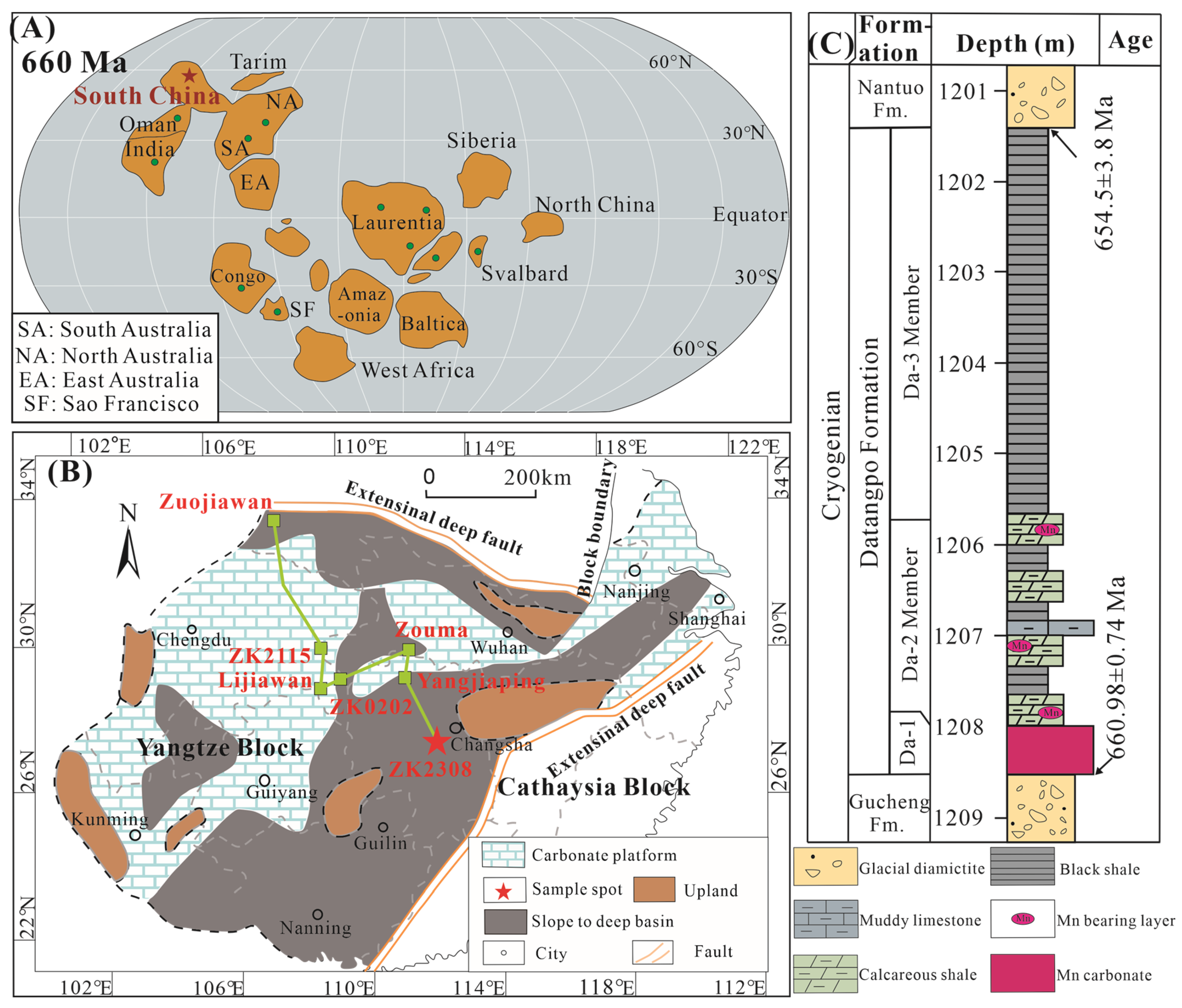
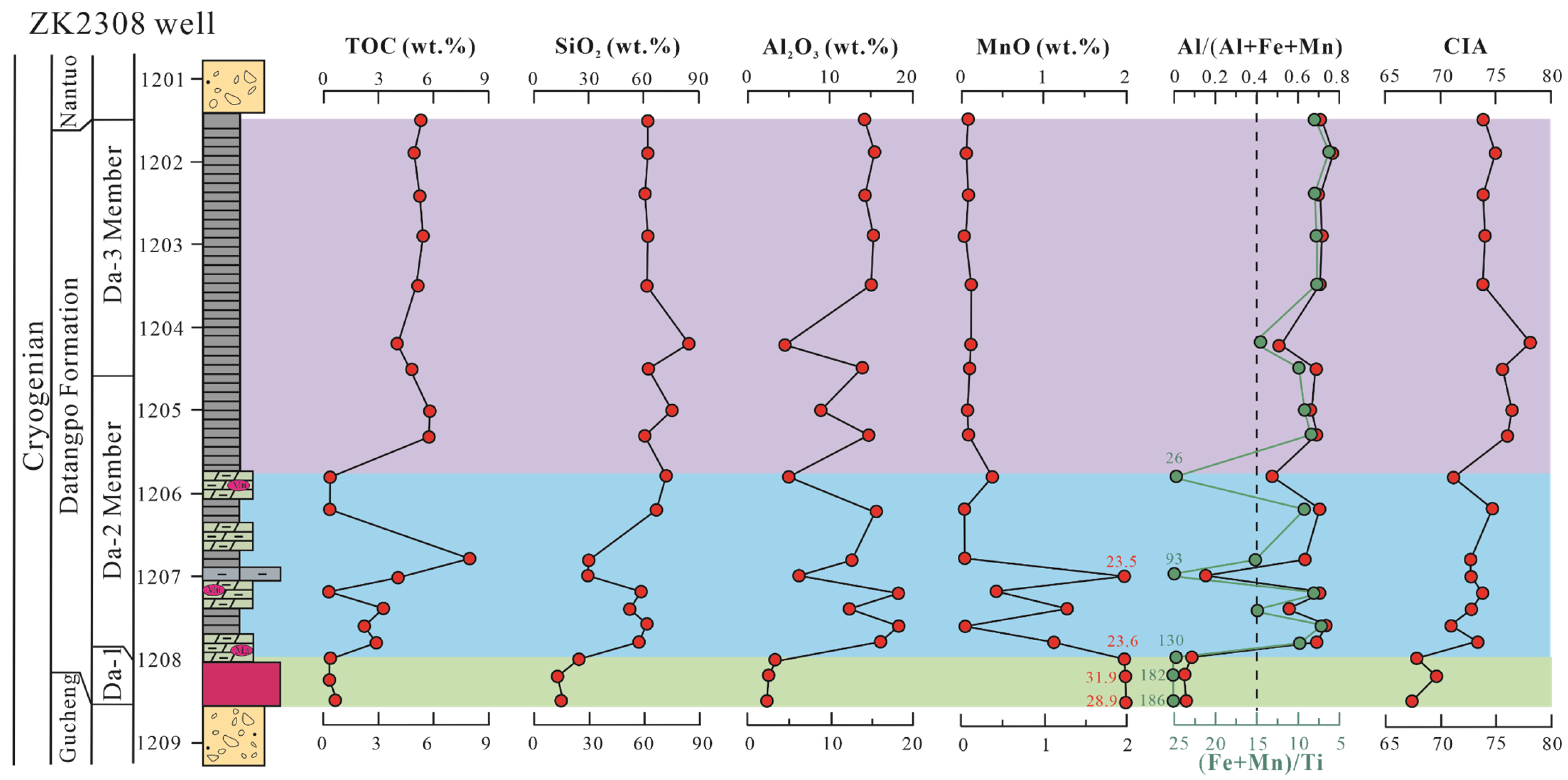
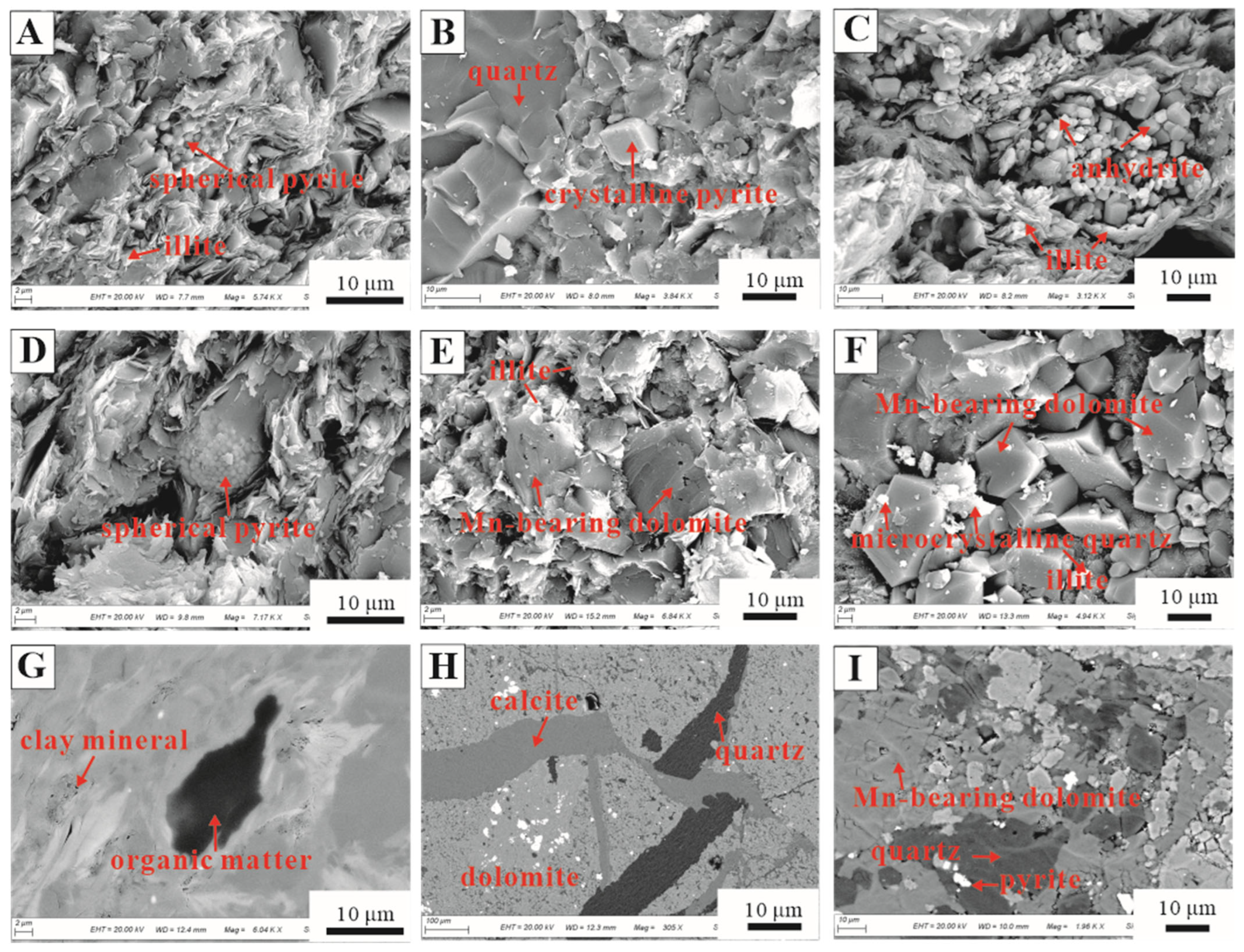
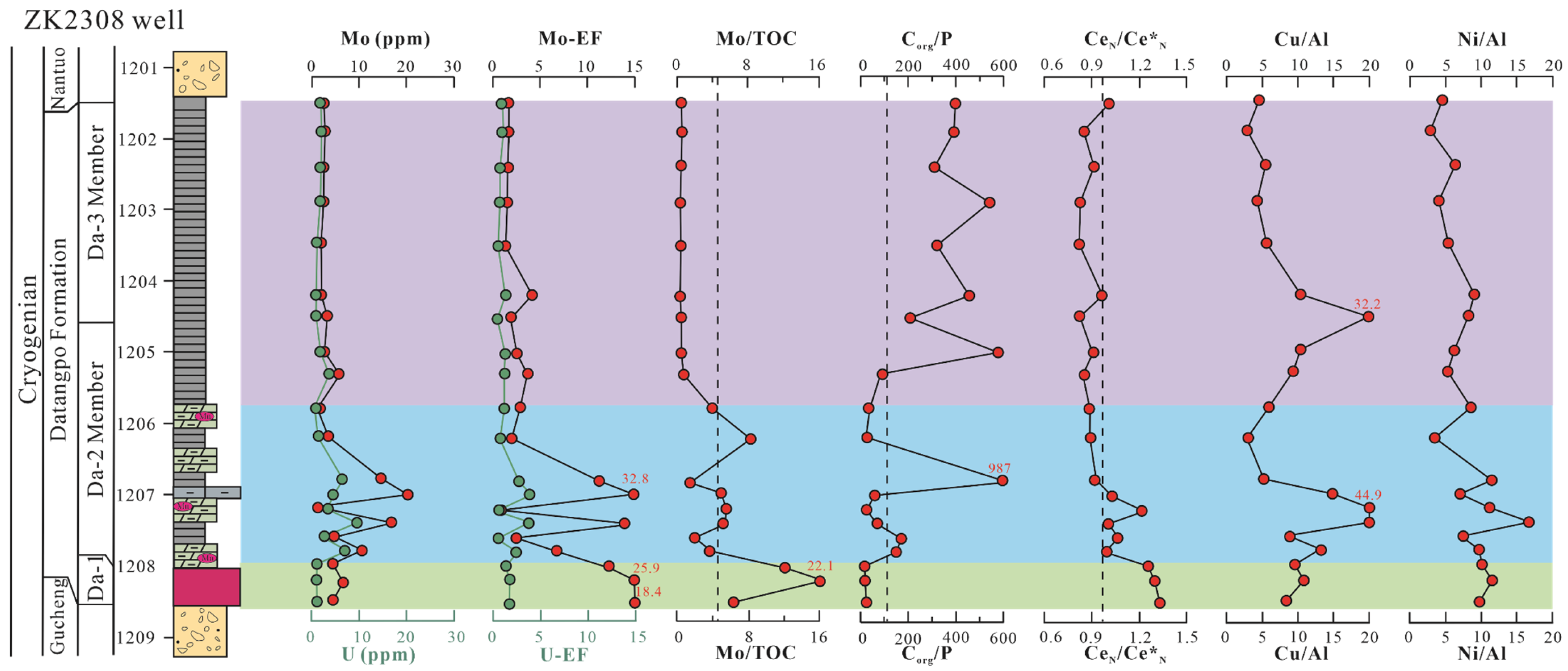

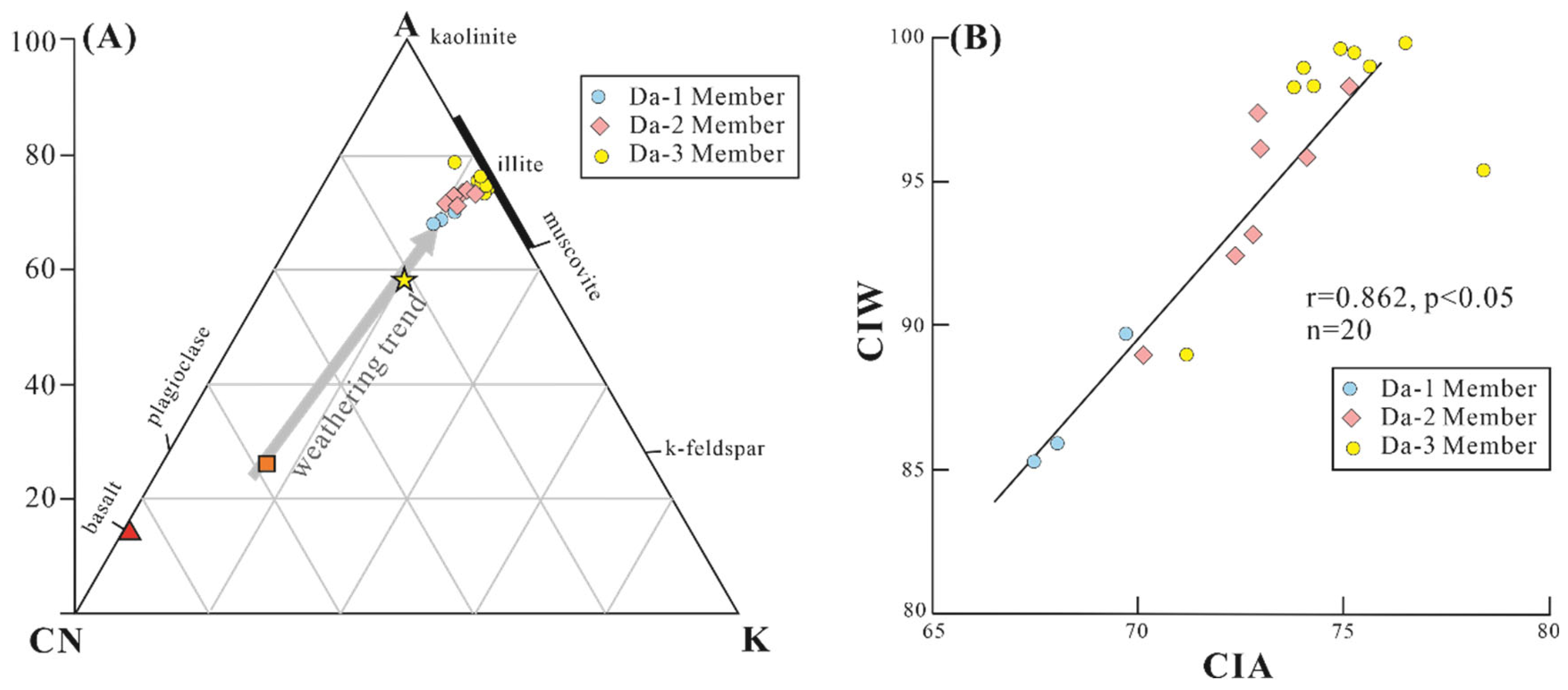




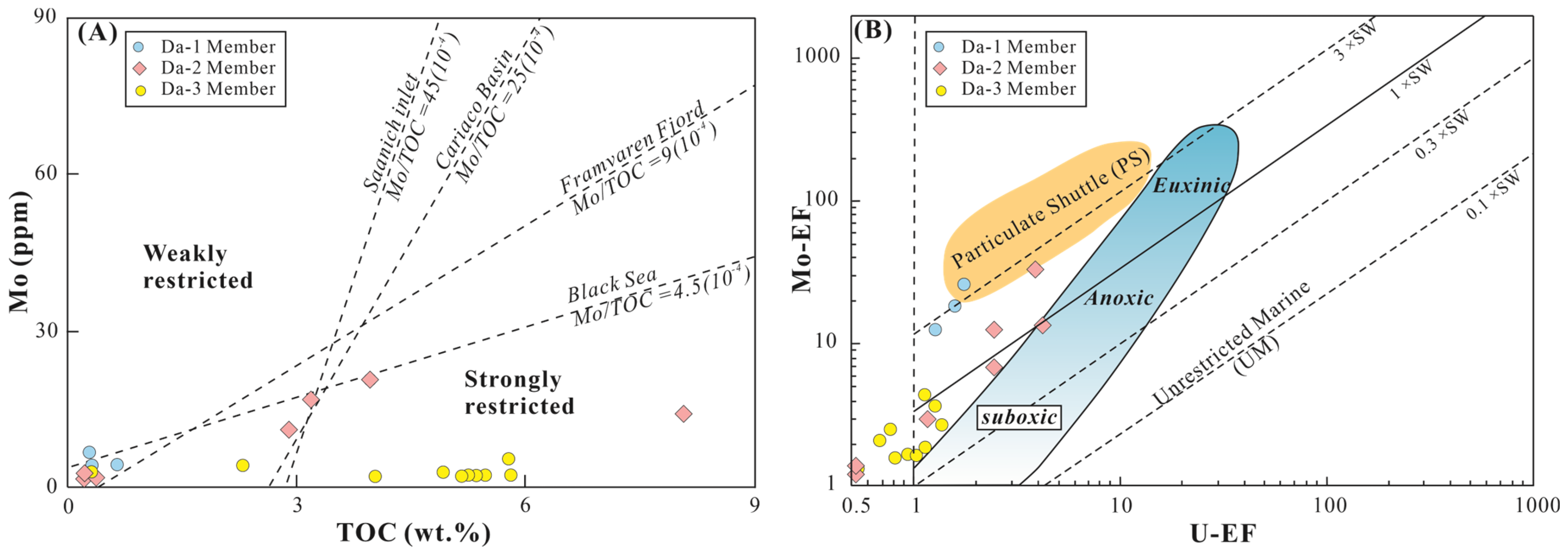


Disclaimer/Publisher’s Note: The statements, opinions and data contained in all publications are solely those of the individual author(s) and contributor(s) and not of MDPI and/or the editor(s). MDPI and/or the editor(s) disclaim responsibility for any injury to people or property resulting from any ideas, methods, instructions or products referred to in the content. |
© 2025 by the authors. Licensee MDPI, Basel, Switzerland. This article is an open access article distributed under the terms and conditions of the Creative Commons Attribution (CC BY) license (https://creativecommons.org/licenses/by/4.0/).
Share and Cite
Jiao, P.; Xiao, R.; Tan, S.; Xie, Y.; Fang, H.; Wen, Z.; Wang, Z. Evaluating Depositional Environment and Organic Matter Accumulation of Datangpo Formation in Central Hunan Province, South China. Minerals 2025, 15, 366. https://doi.org/10.3390/min15040366
Jiao P, Xiao R, Tan S, Xie Y, Fang H, Wen Z, Wang Z. Evaluating Depositional Environment and Organic Matter Accumulation of Datangpo Formation in Central Hunan Province, South China. Minerals. 2025; 15(4):366. https://doi.org/10.3390/min15040366
Chicago/Turabian StyleJiao, Peng, Rong Xiao, Shimin Tan, Yu Xie, Hanqi Fang, Zhigang Wen, and Zhanghu Wang. 2025. "Evaluating Depositional Environment and Organic Matter Accumulation of Datangpo Formation in Central Hunan Province, South China" Minerals 15, no. 4: 366. https://doi.org/10.3390/min15040366
APA StyleJiao, P., Xiao, R., Tan, S., Xie, Y., Fang, H., Wen, Z., & Wang, Z. (2025). Evaluating Depositional Environment and Organic Matter Accumulation of Datangpo Formation in Central Hunan Province, South China. Minerals, 15(4), 366. https://doi.org/10.3390/min15040366




